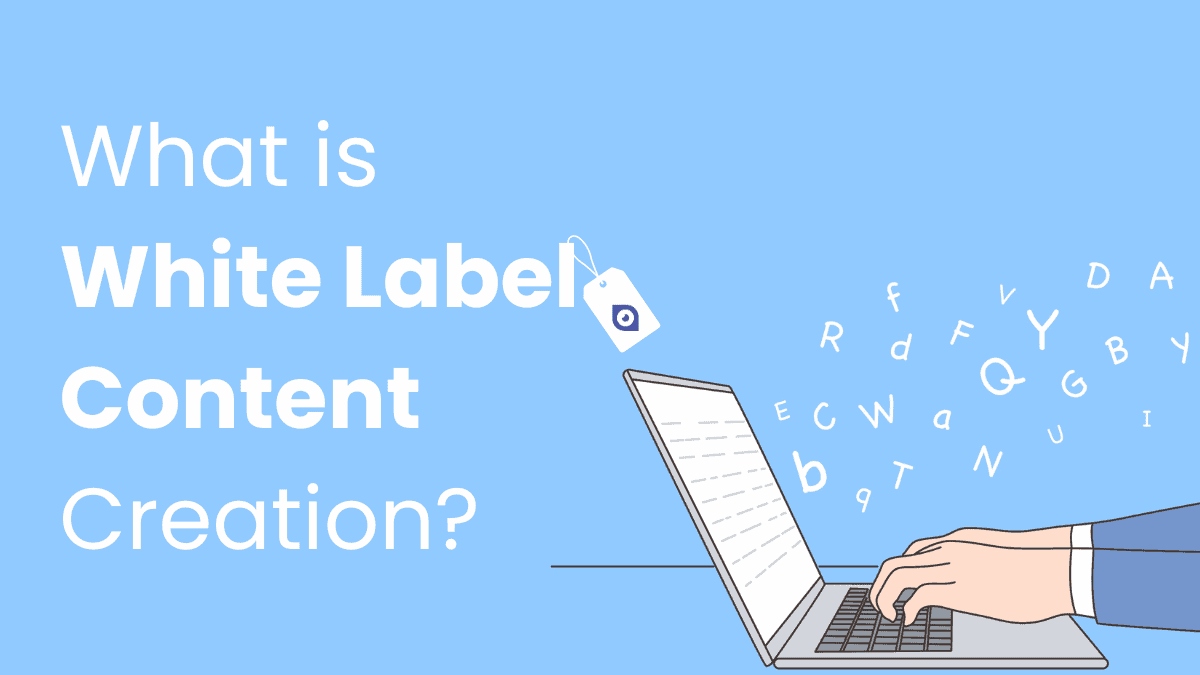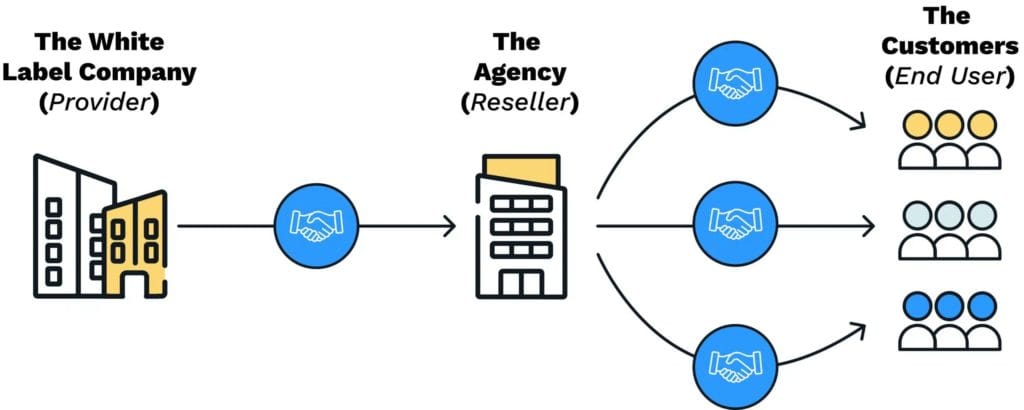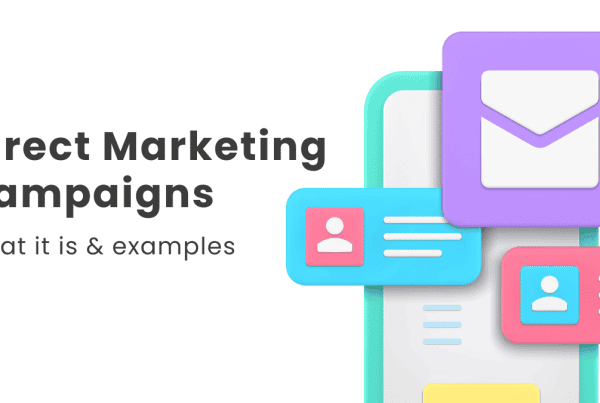
In today’s competitive world, businesses of all sizes need digital marketing. Marketing isn’t complete without content, which is why there’s a high demand for it.
Content is a powerful tool for attracting people, buyers, and leads to your business. It helps build credibility and reliability for your brand. Content can come in various forms, including videos, photos, graphics, podcasts, blogs, audiobooks, and eBooks.
DemandSage reports that businesses that post 16 or more blogs each month tend to get 4.5 times more leads than those that don’t post as much. This is why content writing services are important.
However, keeping up with content creation can be challenging, especially for small businesses. You might need content but lack the time or resources to create it yourself. This is where white label content writing comes in handy.
But what exactly is white label content writing? Let’s explore how it works and what to look for when choosing a white label content writing service.
What is White Label Content?
White label content is when you hire a third party, such as a freelancer, agency, or copywriter, to create content for your business. This content is produced under your brand’s name, giving you complete ownership and control over it. You can publish and distribute the content as if it were created in-house, maintaining your brand’s consistency and authority.

According to Marketing Insider Group, White label content allows businesses to brand and sell content produced by another company, facilitating expanded content offerings without in-house production.
To understand it better let’s take an example, imagine you hire us to write a blog post for you. We create a high-quality blog post, but instead of publishing it under our name, you get the byline. You can choose to attribute the post to a subject matter expert or another member of your team.
Think of white label content as hiring a ghostwriter who creates content for you, but with the final product bearing your brand’s name. The key takeaway is that white label content is entirely yours, and you can use it however you wish. No one will know that someone else wrote it unless you choose to share that information.
Content marketing is now recognized as an effective strategy for business growth.
Studies show that companies that blog regularly gain 67% more leads and 97% more backlinks compared to those that don’t.
This highlights the crucial role of strategic content in enhancing online visibility and driving business engagement. As businesses become more aware of this, the demand for content continues to rise. However, not all marketing firms can meet this demand on their own, which is where white label content writing services come into play.
Why Use White Label Content Services?
Marketing Insider Group says that partnering with white label content providers provides expertise, scalability, quality, diverse offerings and cost-efficiency without the need for a full-time team. There are several reasons why white label content might be perfect for your business:
Time and Cost Efficiency
Working with a white label content team saves you time and money. Plus, you avoid the lengthy and costly process of hiring an in-house marketing team.
Maintaining High-Quality Standards
A white label content team consists of experts who deliver high-quality content for your business. They create copy that ranks well in search engines and attracts buyers to your website.
Expanding Service Offerings
A third-party white label content team can produce various types of content, including blogs, social media posts, emails, and website content. This helps expand your company’s services, which is especially beneficial for digital marketing agencies.
Focusing on Core Business Activities
By outsourcing content creation, you can concentrate on other important aspects of your business, such as sales and performance, while the content team handles the content.
Types of White Label Content
White label content comes in different forms to meet your business needs. Here are some common types:
White Label Blog Content
White Label Blog Content includes blog posts written by a third-party team but published under your brand’s name. These posts cover topics relevant to your industry and audience, helping to drive traffic to your website, improve SEO rankings, and establish your brand as an authority. This way, you can keep your blog updated with fresh content without writing it yourself.
White Label Social Media Content
According to DataReport’s April global overview, more than half of the world’s people now use social media (62.6%). In such a situation, it is very important to maintain social media profiles these days. White Label Social Media Content consists of posts, images, videos, and other content for social media platforms like Facebook, Twitter, Instagram, and LinkedIn. This content reflects your brand’s voice and style, helping you engage with your audience consistently. Using white label social media content keeps your social media presence active and engaging without requiring much time and effort.
White Label SEO Content
White Label SEO Content is designed to improve your website’s search engine rankings. This includes keyword-optimized articles, blog posts, and landing pages. The goal is to attract organic traffic by making your content easily discoverable by search engines. High-quality SEO content helps improve your site’s visibility and convert visitors into customers, all while adhering to the latest SEO best practices.
White Label Website Content
White Label Website Content covers all the text and multimedia elements on your website, such as homepage copy, product descriptions, service pages, and the about us section. This content is crucial for creating a professional and trustworthy online presence. White label website content ensures your website communicates your brand message effectively and resonates with your audience, all without you needing to write it yourself.
White Label Case Studies and White Papers
White Label Case Studies and White Papers are detailed documents about your products, services, or industry trends. Case studies showcase real-life examples of how your solutions have helped clients, adding credibility to your offerings. According to a 2016 B2B content marketing report, 63% of B2B companies see white papers as one of the most effective forms of content they use in their organization. White papers provide in-depth insights and research on specific topics, establishing your brand as a thought leader. With white label case studies and white papers, you can present well-researched and professionally written documents that enhance your brand’s authority.
Label Ebooks and Long-Form Content
Netline’s 2024 Content Consumption Report shows that ebooks are still the most favored type of B2B content, with a 34.5% rise in registrations compared to last year. White Label Ebooks and Long-Form Content are extensive pieces of content that provide valuable information on a specific subject. Ebooks can be used to attract potential customers, while long-form content like guides or tutorials can improve your site’s SEO and engagement. These types of content offer deep insights and solutions, helping to educate your audience. By using white label ebooks and long-form content, you can provide high-value resources without spending the time and effort to create them yourself.
The White Label Content Creation Process
White label content creation is a collaborative process between you and your content partner (such as a freelancer or content agency). While every agency is unique, here’s a standard process to get you started:
Step 1: Communicating with Your Content Partner
Start by informing your content partner about the new project. Clearly communicate the project details to ensure everyone is on the same page and deadlines are met. This can be done via email or through a shared document. Providing clear and concise project information helps prevent misunderstandings and ensures a smooth workflow.
Step 2: Providing a Detailed Content Brief
A content brief is crucial for setting expectations and providing all necessary information. This includes the topic, target audience, key messages, and any specific guidelines. A comprehensive brief saves time and helps the writer deliver content that meets your requirements. In some cases, an interview with the writer might be necessary for more complex projects.
Step 3: Reviewing and Approving Content
After receiving the first draft from your content partner, review it thoroughly. Provide detailed feedback to ensure the content aligns with your vision. Be specific with your comments to help the writer make the necessary adjustments. Remember, feedback is a vital part of the process to achieve the desired quality.
Step 4: Delivering Content to Clients
Once you’re satisfied with the content, send it to your client for their review. They may request further revisions or provide feedback. Ensure you communicate this feedback clearly to your content partner. The content partner will then make the required changes and send the final version back to you for delivery to the client.
Step 5: Rinse & Repeat
Repeat this process for all future projects. As you become more familiar with your content partner’s working style, you may refine your process for even better efficiency. Continuous communication and clear instructions will help maintain a smooth workflow.
This process can be adjusted to fit the unique needs of your business and content partner. Effective communication and collaboration are key to a successful white label content creation process.
How to Choose the Right White Label Content Service
Selecting the right white label content service is crucial for ensuring high-quality content that reflects well on your brand. Here’s how to make the best choice:
Evaluating Content Providers
When choosing a white label content provider, start by understanding their processes and expertise. Look for providers who:
- Have Proven Processes: Opt for a provider with a clear, efficient process for managing projects. This ensures they can start working on your projects right away and handle them smoothly.
- Are Experienced in Your Niche: Check if the provider has experience in your industry or is willing to learn about it. This helps ensure the content they create will be relevant and engaging for your target audience.
- Have a Track Record of Success: Review their testimonials and request writing samples to gauge the quality of their work. A proven track record indicates they can deliver content that meets your standards.
Quality Control Measures
Quality is key in white label content. To ensure you receive top-notch material:
- Understand Their Quality Checks: Ask about the steps they take to ensure content quality. This might include proofreading, editing, and adherence to style guidelines.
- Inquire About Revision Policies: Find out how they handle revisions. A good provider will be open to making necessary changes to meet your expectations.
- Check Client Reviews and References: Look at feedback from their previous clients to see if they deliver on their promises. You might also request references to get firsthand accounts of their reliability and quality.
Customization Options
To make sure the content aligns with your brand, consider:
- Customization Capabilities: Check how flexible the provider is in customizing content to fit your brand’s voice and style. This ensures the final product feels like it’s truly yours.
- Client Input: Ensure the provider values your input throughout the content creation process. Good communication and collaboration are essential for achieving the best results.
Pricing Models and Contracts
When evaluating pricing:
- Compare Costs: Don’t assume that higher prices mean better quality. Compare prices from different providers to understand the market rate and negotiate better terms if needed.
- Understand Pricing Structures: Look at what’s included in their pricing packages. Ensure you’re not paying for services you don’t need and that the package aligns with your requirements.
- Review Contracts Carefully: Read the fine print of any contract before signing. Make sure you understand the terms, including any limitations on revisions or additional fees.
Choosing the right white label content service involves evaluating their expertise, quality control, customization options, and pricing to find the best fit for your needs. With the right partner, you can enhance your content strategy and boost your brand’s presence.
Integrating White Label Content into Your Business
Incorporating white label content into your business can streamline your content creation process and enhance your offerings. Here’s how to make the integration smooth and effective:
Creating a Seamless Workflow
To ensure a smooth integration of white label content:
- Set Up Clear Processes: Establish a clear workflow for how you’ll work with your content provider. This includes how you’ll communicate project details, handle revisions, and track progress.
- Use Collaboration Tools: Utilize tools like shared documents, project management software, or communication platforms to keep everything organized and ensure everyone is on the same page.
- Define Roles and Responsibilities: Clearly outline who is responsible for what in the content creation process, both on your team and with your content partner. This helps avoid confusion and ensures timely delivery.
Providing Clear Content Briefs
A detailed content brief is crucial for getting the content you need:
- Include Essential Details: Provide your content partner with all necessary information, such as the topic, target audience, key messages, and any specific guidelines or examples.
- Be Specific About Your Needs: Clearly state what you want from the content, including the tone, style, and any particular points that must be covered. This helps the content partner produce work that meets your expectations.
- Communicate Expectations: Make sure your content partner understands your goals and objectives. This ensures the content aligns with your brand’s voice and meets your business needs.
Promoting and Distributing Content
Once the content is ready, it’s time to get it out there:
- Plan Your Promotion Strategy: Decide how you’ll promote the content through your channels, such as social media, email newsletters, or your website.
- Use Distribution Channels: Share the content on platforms where your audience is active. Tailor the distribution strategy to reach your target audience effectively.
- Engage with Your Audience: Interact with your audience by responding to comments or questions about the content. This helps build engagement and increases the content’s impact.
Measuring Success and Gathering Feedback
To ensure the content is working well:
- Track Performance: Use analytics tools to monitor how the content is performing. Look at metrics like views, shares, and engagement to gauge its effectiveness.
- Gather Feedback: Collect feedback from your audience and clients to understand what’s working and what can be improved. This helps you refine future content and better meet your audience’s needs.
- Adjust and Improve: Use the insights from your performance data and feedback to make adjustments to your content strategy. Continuous improvement ensures your content remains relevant and effective.
By following these steps, you can effectively integrate white label content into your business, ensuring a smooth workflow, clear communication, successful promotion, and ongoing improvement.
Conclusion
As the need for high-quality content grows, white label content services are becoming increasingly valuable for businesses and agencies. These services are expected to become more advanced, with better technology and content strategies making them even more effective.
Looking ahead, white label content will likely become more personalized and efficient. With improvements in AI and automation, content creation will be faster and more tailored to fit your brand’s needs, helping you stay competitive.
For agencies, white label content can save time and reduce costs, letting you focus on your main business activities. Make sure to choose a provider with a good track record, use clear communication, and track performance to keep improving. By integrating white label content effectively, you can enhance your offerings and drive success for your clients and your business.
Frequently Asked Questions
What types of businesses can benefit from white label content services?
White label content services can benefit a wide range of businesses, including marketing agencies, small businesses, e-commerce companies, and any organization looking to enhance their content strategy without handling production in-house.
How do white label content services handle SEO and keyword optimization?
Many white label content providers include white label local SEO and keyword optimization as part of their services. They should be familiar with best practices for on-page SEO and keyword integration to help improve your content’s visibility in search engines.
What happens if I’m not satisfied with the content provided by a white label service?
Most providers offer revision policies to address any concerns you may have. Be sure to understand their revision terms and communicate your feedback clearly to ensure the content meets your expectations.



